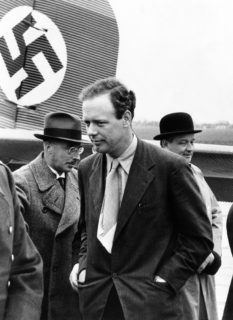
And now, the Minneapolis-St. Paul International Airport’s Lindbergh terminal is being targeted by opponents of the memorialization of historical figures with a questionable past.
In an op-ed in today’s Star Tribune, Liam Hoare, a freelance writer from Vienna, acknowledges the historical contributions Lindbergh made to aviation, but says by the time the terminal was dedicated in 1985, too much was known about his political past to justify the gesture.
There cannot be a more complicated person who ever emerged from Minnesota’s cocoon than Lindbergh, who grew up in an unhappy home in Little Falls, ushered in the era of long-distance flight, and lived with a fame that is incomprehensible by today’s standards. He was the most famous person in the world.
He was also an anti-Semite, as were others — Henry Ford, for example — who rallied around the America First organization to keep the U.S. out of World War II.
Having visited Germany several times during the 1930s, Lindbergh was a Nazi sympathizer as war approached. In 1938, he accepted the Order of the German Eagle from Hermann Göring, who would be sentenced to death for war crimes and crimes against humanity at Nuremberg in 1945. Of Adolf Hitler, Lindbergh’s wife wrote in her diary that he “is a very great man, like an inspired religious leader … a mystic, a visionary who really wants the best for his country and on the whole has rather a broad view.”
Lindbergh’s “inclination toward Fascism is well known to his friends,” columnist Dorothy Thompson wrote in 1939. Once war came to Europe, he agitated for appeasement, including as a spokesperson for the notorious American First Committee.
Lindbergh argued that Western civilization depended on American neutrality and cooperation with Nazi Germany. In an August 1940 address, he condemned “accusations of aggression and barbarism on the part of Germany,” five years after the anti-Jewish Nuremberg Laws were passed and seven after the first concentration camp for political opponents was erected at Dachau.
Hoare’s view collides somewhat with that of A. Scott Berg, the author of the biography, Lindbergh, who noted that Lindbergh essentially spied on the German military buildup, using his fame to gain access and favor from German hosts, and reporting back to the U.S. government.
He was impressed with Germany’s recovery from World War I. He doubted whether the United States could win a war against it.
“I don’t think that’s true,” Lynne Olson said of the allegation that Lindbergh was a Nazi sympathizer.
“He saw what he wanted to see,” said the author of Those Angry Days, a book which explored the pre-war collision between Lindbergh and Franklin Roosevelt over the rise of the Nazi military machine.
But his anti-Semitic and white supremacist views were clear and, worst of all, he never retracted them before his death in 1974.
Says Hoare:
This is not a call to start tearing down the Charles A. Lindbergh Historic Site in Little Falls tomorrow morning, but rather a suggestion that a modest alteration be made at the gateway to Minnesota.
Whatever his merits in the field of aviation, that the main airport terminal continues to be named after a prominent anti-Semite and Nazi sympathizer is at once an insult and a disgrace. As Virginia debates what best to do about one of its problematic native sons, Minnesota should ask what to do about Little Falls’ own, too.
Though it remains only as a suffix, a final retitling would be the right thing to do. Terminal 1-Lindbergh should be no more.
A commenter to the op-ed makes a valid point, however, in the obvious attempt to draw a parallel with the removal of Confederate memorialization. The various statues, many erected during the civil rights struggle of the ’50s, were a passive aggressive memorial to treason and racism.
Lindbergh’s memorialization, on the other hand, were solely on his aviation exploits, which were eclipsed on the planet only by two brothers from Dayton, Ohio.
His fame as an aviator was honorably earned.
